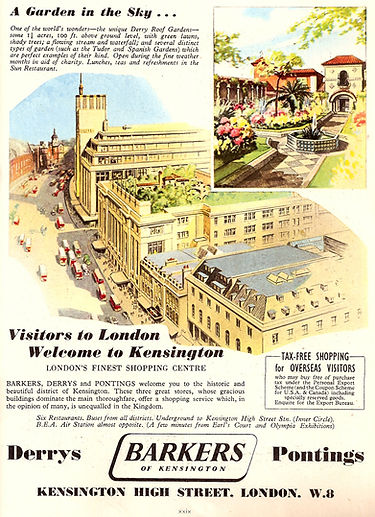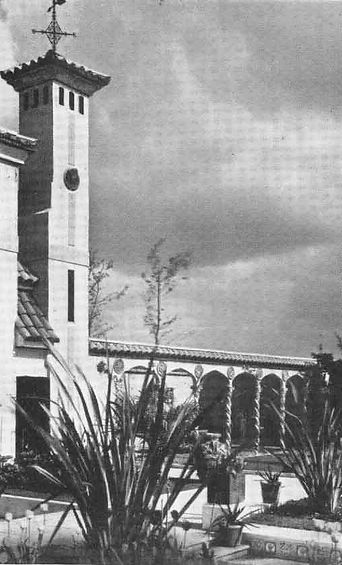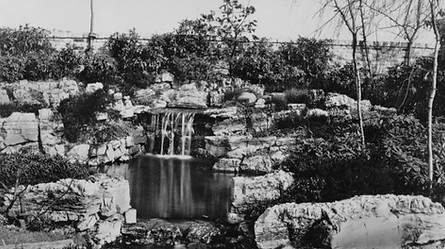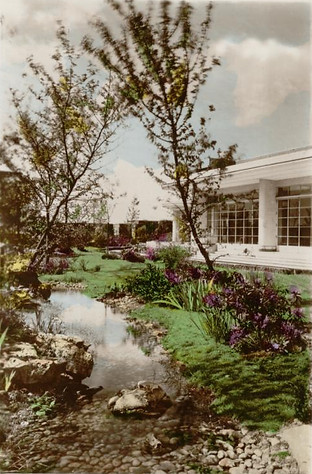The Roof Gardens at Derry and Toms

Derry and Toms
In 1853 Joseph Toms opened a small drapery shop on Kensington High Street, and nine years later in 1862 Toms joined forces with his brother-in-law, Charles Derry, to set up Derry & Toms. By 1870 the business had grown to incorporate seven of the surrounding stores, with one of the buildings being used as a mourning department. The company prided itself as being the supplier of goods to the upper class of Kensington. By 1920, John Barker & Co., the large department store next door, had acquired Derry & Toms. Their expanding empire already owned Pontings, which was adjacent to Derry & Toms.
In 1929, the Barkers Board decided that the numerous buildings which made up Derry and Toms were no longer fit-for-purpose. They commissioned architect Bernard George to design a new, grander department store which would be in the Art Deco Style, popular at the time. The new building would feature metalwork by Walter Gilbert with panel reliefs, entitled Labour and Technology, by Charles Henry Maybe Jr. For a more detailed look at the history of Derry and Toms look here.
Building work took place between 1931 - 1933 and included plans for a seventh floor. At the time the London County Council forbade the inclusion of the seventh floor due to the limit of the London Fire Brigades ladders but the building had the structural potential for another floor. On completion of the building, Barkers Managing Director, Trevor Bowen, who had visited New York City and had seen for himself the Gardens of the Nations, commissioned Ralph Hancock to create similar gardens on the empty roof space.
Derry Gardens
This time Hancock was to build three gardens, each with its own unique style and planting. As these plans show, the gardens were; a Tudor Garden complete with herringbone brickwork, impressive Tudor arches and much wrought iron. A splendid Spanish garden with palm trees and fountains as well as Moorish colonnades. And a woodland garden, built with a cascade, a river and grassy banks. These other plans are taken from a 1950’s promotional booklet published by Derry and Toms.
As with the works in New York, the logistics involved in the construction were impressive. Before planting and building could start a thick bitumastic base was laid on the roof, followed by a layer of loose brick and rubble that was arranged in a fan-like pattern to aid drainage. On top of this was a layer of topsoil of between 18 and 36 inches, into which the planting was made. Water came from Derry and Toms own artesian wells. On opening day the gardens contained over 500 different varieties of trees and shrubs.
The gardens were completed in 1938 at a cost of £25,000 and were officially opened by the Earl of Athlone on 9th May of that year. Visitors were charged a shilling (5p) to tour the gardens. Monies raised that year were donated to the Queen's Institute of District Nursing. Over the next 30 years over £120,000 was also raised for local hospitals.
Esme Bradburne
The year before work on Derry Gardens was completed, Ralph had been approached by an ambitious young plantswoman after she had seen his garden at the 1937 Chelsea Flower Show. Keen to employ someone who could look after his plants and planting, Ralph offered Esme 10 shillings a week to come and work for him. It is understood that Esme was responsible for much, if not all the planting of the Derry Gardens. Esme remained with Ralph’s company until mid 1938 when she left to join her cousin, a senior British diplomat In Afghanistan. You can read more about Esme by clicking here.


The green Moroccan leather bound visitors book from the opening day.
The book currently resides at the Kensington Library along with other volumes of visitors books

Trevor Bowen, right, seen on Opening Day
with invited guests

A little illustrated guide

A magazine advertisement from the 1950's
The magazine advertisement above shows the gardens in all their spectacular glory. Unfortunately, the orientation of the Spanish bell tower and building is incorrect. They both should sit squarely with the front of the department store. This drawing may have been made from Hancock's early sketches and plans of the gardens?
A year after the gardens were opened, a telescope was added to one of the viewing platforms so that visitors could gaze on the distant Surrey Hills or, if they wished, over Kensington and the surrounding roof tops.
The following series of photographs and period postcards show the gardens as they were when Hancock completed his work in 1938. Many of the original trees are covered by tree preservation orders, and the beautiful gardens themselves are now Grade II* listed.
The Spanish Garden

The Bell Tower

Raised seating area with flower beds below

The well of Saint Theresa


The Spanish Garden and Bell Tower
The Spanish Garden and Bell Tower after a 250 pound bomb
landed in the gardens during World War Two
The Tudor Garden

The hexagonal Tudor courtyard

The Cloister walkway

The Tudor courtyard

Tudor Arch detail
The Woodland Garden
.jpg)
A wooden bridge crosses the stream

One of two stone bridges

The plaque to Trevor Bowen the Managing Director of Barkers who commissioned Ralph Hancock to build his vision of
"A Garden in the Sky"

The Sun Pavilion and Terrace

The Woodland Garden Waterfall

The Woodland Garden stream
World War Two
During World War Two the Roof Gardens hosted a great number of events to raise money for comforts for servicemen and women. Senior politicians, high ranking military personnel as well as foreign Royalty such as King Haakon and Prince Olaf of Norway, Queen Marie of Yugoslavia, Prince Bernhard of the Netherlands, the Duchesses of Marlborough, Devonshire and Richmond; were frequent visitors. Even Queen Mary was a regular.
The two volumes of Green Moroccan leather-bound Visitors Books, which are held in the Kensington Central Library, also contain the autographs of many stage and screen stars from both sides of the Atlantic; Dame Marie Tempest, Dame Irene Vanbrugh, Sir John Gielgud, Sir Cedric Hardwicke, Leslie Howard, Ruth Draper, Sir George Robey, Elizabeth Bergner, Alice Delysia and Ivor Novello could be seen taking in the peaceful surroundings. The gardens were also used to entertain parties of allies from overseas; when they made a pleasant retreat from the clamour and destruction which menaced London in the dangerous years.
Trevor Bowen, who was by then the Chairman of Barkers, saw to it personally that, despite rationing and severe shortages, the store kept going. And, after his own house in Putney Hill was destroyed in another raid in February 1944, he took to a basement office at Derry and Toms from where he operated for the remainder of the war.
Air-raids and Bombs
The first German bomb fell during an air-raid on the night of June 15th, 1940, a 250-pounder crashed on to the roof garden of Derry & Toms, fell down one of the main front staircases, and burst on the fourth floor. John Barker’s old shops would undoubtedly have been smashed into pieces by such an explosion; but the sturdy new building withstood the blast, though the stock and fittings were badly damaged. The Campanile within the Spanish Garden was almost destroyed, see above photograph.
The "worst night of all" was April 16th, 1941, when a stick of four bombs fell across the High Street and Kensington Square. One of them, a 1000-pounder, crashed through the roof of Derry & Toms – in almost the same position as the 250-pounder of the year before – and broke in half on the fourth floor.

A First World War issued helmet re-issued to a Fire Guard at Derry and Toms during World War Two
The bomb failed to explode, otherwise the whole store would have been destroyed; but it did cause a dangerous blaze on the fourth floor. The company’s own team of fire-fighters managed to save the splendid building, but much of the department was badly damaged and had to remain closed until the end of the war.
After the war ended, the Campanile, which had been badly damaged during that first air-raid was rebuilt by Ralph and Bramley.

Admiral Sir Edward Evans (Lord Mountevans),
King Haakon of Norway, Trevor Bowen and
H.M. King Olav, in 1945

Trevor Bowen with General Sir Alexander Hood
and Mrs Violet Attlee in 1945

Trevor Bowen with H.R.H. the Duchess of Kent in 1940

Trevor Bowen with Miss Diana Wynyard and some other interested parties at a fundraising event during the war

A Garden in the Sky
in 1960, the story of Barkers of Kensington, 1870-1957 written by D.W. Peel was published. The book examines the history of the Derry and Toms parent company and gives examples of the stores own colourful history.
The slim volume gives an incredible insight as to the men who created a successful retail empire as well as recounting the years in which Trevor Bowen was in control.
Despite the roof gardens playing a huge part in Bowen's career, there is very little mention of them, nor of their creator, Ralph Hancock. In deed, the latter gets only the briefest of mentions in passing!
